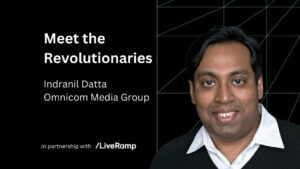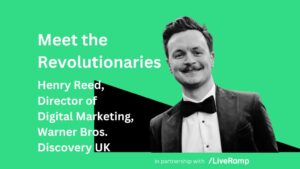New Digital Age (NDA) in association with LiveRamp, is spotlighting the men and women championing a data-led revolution in the marketing industry. ‘Meet the Revolutionaries’ focuses on the efforts of the industry executives helping to push digital marketing into a new era of data collaboration.
Here, we chat with Peter Young, who at the time of our conversation, was about to take up his new role as Director of Performance Marketing at online fashion retailer Farfetch. Young explains that innovation isn’t something that “just happens” without the appropriate time and space…
Tell me a little about your career to date.
I have just started my new role as Director of Performance Marketing for Farfetch, heading up the Marketing teams for their Platform Solutions offering – an end to end solution for luxury brands and retailers.
Prior to that I was Marketing Director of THG Ingenuity, where I was primarily responsible for the delivery and the product roadmap of our martech stack, which involved a lot of work across the whole group.
My particular passion point was looking at how we could use technology to enhance our capabilities and to tailor our messaging to specific audiences. When I started with the company, they weren’t doing much beyond traditional CRM, so a lot of the work I did was to build that out and allow us to actually leverage the first-party data we had and enhance what we already had in place. A big part of that was learning to work more closely with collaborators such as LiveRamp.
Are there any examples of times that you have driven innovation inside your organisation?
A specific example is that I led on changing the way we used data at THG Ingenuity in order to generate deeper insights and underpin the work we were doing for our clients. I was heavily focused on developing the roadmap, both in terms of what we needed to concentrate on and how some of the different elements of our tech stack would fit together. Often, when people consider innovation inside an organisation, it’s often in isolation from the bigger picture. In my experience, by taking a couple of steps back at the start of an innovation project, you can end up having a much bigger impact in terms of where you focus your time and effort.
Once you’ve identified the most impactful innovations to work on and the tech solutions have been built out, a big part of the job is helping your teams to utilise the tech and enhance what they are doing on a day-to-day basis.
What, in your experience, are the key challenges to innovation?
I wouldn’t say financial concerns are necessarily a barrier. For me, innovations are often held back by three things.
The first is a lack of mental availability. I think in a lot of businesses, everyone is working flat-out and there’s no time or appropriate environment set aside for people to think in an innovative way. You’ve got to make a bit of space, both mentally and physically, to allow innovation to happen.
Secondly, culture and buy-in. You don’t often find good innovation in bad company cultures. Having a culture that inspires people and engages them to ask questions and solve problems is essential.
Thirdly, is the issue of ownership. Once a change has been made, make sure that there’s someone internally who retains ownership of the innovation, constantly assessing its impacts and driving refinements and developments to what’s already been done.
What advice or tips could you offer around encouraging innovation?
Innovation isn’t something that just happens, it has to be fostered. It isn’t an accident that innovation really thrives inside organisations like Google. They have that time set aside, in certain teams, for people to actively build out their own projects. Creating that environment, that culture, that framework for people to be able to think and then share their ideas is key. Individual people can come up with good ideas, but I think the magic really happens when you then allow them to work with others who can see things from another angle.
What technological or organisational innovations do you think will be most important over the next few years?
Everybody’s going to say AI, which is obviously going to become important. Outside of that, one thing I’m keeping a close eye on is what’s happening with the social platforms. A lot of our current approach to digital marketing is built around driving people from a platform, to a site or an app. When you look at what Tiktok is doing and what Meta are doing around commercialising their own environment, with in-feed purchases for example, it’s very interesting. So a TikTok viewer sees an influencer talk about a dress and the viewer can then buy it instantly in TikTok without ever visiting the retailer’s site. That represents a pretty significant change for digital marketers.
I also try to look at other countries and cultures to see what’s happening over there. If you look at China and see how their social systems are becoming more intertwined with the traditional internet ecosystem, that could also start to have a significant effect on how people transact with brands.
The final area worth watching is simply data. The goalposts seem to be constantly moving around what we can or can’t use from a data perspective. That’s already had a big impact on digital marketing over the past three or four years but I don’t think we’re at the end of that journey yet.












